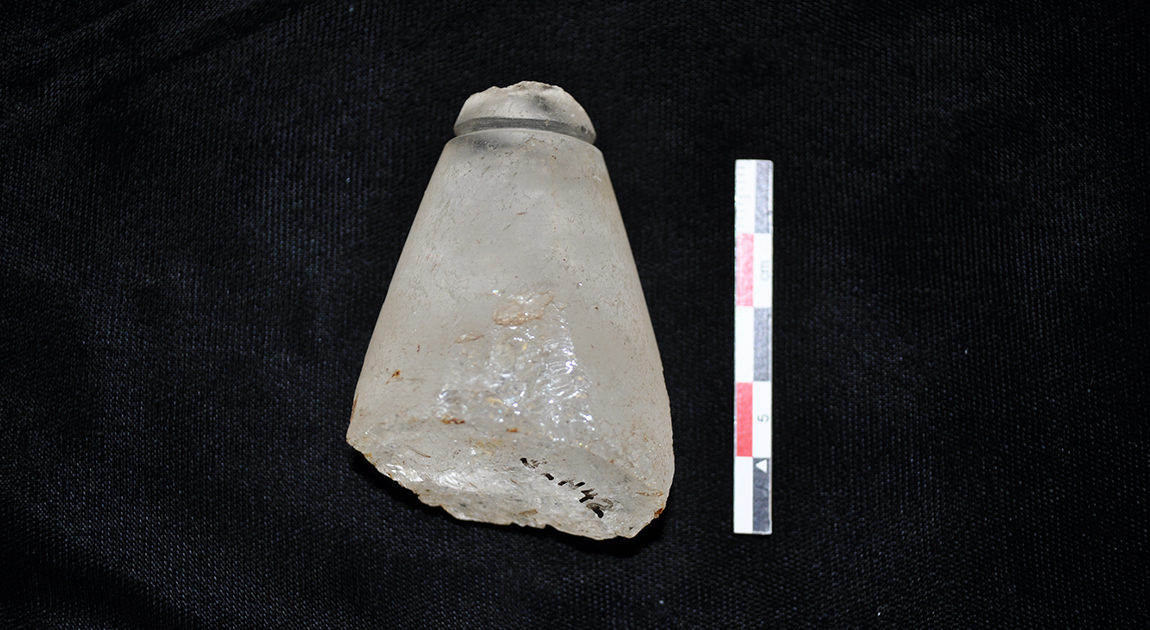
On November 2, 2022, the name of Toltec Mounds Archeological State Park was officially changed to Plum Bayou Mounds Archeological State Park and the ARAS research station was renamed the Plum Bayou Research Station. Learn more...
Katherine Gregory, Arkansas Archeological Survey, Toltec Mounds Research Station
Artifact of the Month - August 2021
This broken groundstone quartz crystal plummet was recovered on the surface at Toltec Mounds (3LN0042) in Lonoke County, Arkansas. These types of artifacts are called plummets because their general shape is similar to that of a modern-day plumb bob. Archeologists differ on the usage of plummet stones: some suggestions include fishing weights, bolas, weights for a loom, or weights for retting (Lipo et al. 2012; Stephens 1951). Plummets used as fishing weights were attached to fishing nets to help keep the nets under water. Bolas are hunting tools that had weights on either end of cord that was thrown to snare birds and other small prey. Retting is used in processing plant fibers for baskets, textiles, etc. Retting requires that the material be weighted down so it stays underwater, allowing the fiber to separate from the bark. Here at the Toltec Mounds Research Station we tried retting paw paw fiber using a plummet as the weight and it worked perfectly.
Before the state acquired Toltec Mounds and made it a state park, many avocational archeologists would walk the recently plowed fields looking for artifacts. This quartz crystal plummet was found in 1972 by Jim Cherry, and we are lucky that he mentioned collecting it in the vicinity of Mound G (Rolingson 2012). Quartz crystals are not a local raw material; they are from the Ouachita Mountains. Other artifacts found by avocational archeologists in the vicinity of Mound G include the head portion of an owl effigy and a large unworked, faceted quartz crystal (Horton 2018; Rolingson 2012).
Plummets are not unique to a particular time period; however, we know that this particular plummet was used by the Plum Bayou people at Toltec Mounds between A.D. 650 and A.D. 1050. Plummets can be found throughout the United States (Lipo et al. 2012).
Plummets come in all shapes, sizes, and raw materials. The Plum Bayou people used all different types of raw material such as chert, novaculite, quartz, and quartz crystal. Quartz crystal is a difficult raw material to work; therefore, archeologists think that the chipped stone and groundstone artifacts made out of quartz crystal were probably not made for normal everyday use. Instead it was likely used for special occasions and maybe for a purpose that has not yet been considered.
Materials: Quartz crystal
Dimensions: 55.2 mm x 40.7 mm x 25.9 mm
Weight: 75.4 grams
Age Estimate: A.D. 650 to A.D. 1050
Accession Number: 2005-377
Courtesy of the Arkansas Archeological Survey
References
Horton, Elizabeth T.
2018. The Toltec Mounds Owl Effigy – December Artifact of the Month.” Arkansas Archeological Survey Artifact of the Month https://archeology.uark.edu/artifacts/owl-effigy/.
Lipo, Carl P., Timothy D. Hunt, and Robert C. Dunnell
2012. “Formal Analyses and Functional Accounts of Groundstone “Plummets” from Poverty Point, Louisiana.” Journal of Archaeological Science 39(2012) 84–91.
Rolingson, Martha Ann
2012. Toltec Mounds: Archeology of the Mound-and-Plaza Complex. Research Series No. 65. Arkansas Archeological Survey, Fayetteville.
Stephens, B. W.
1951. “Middle Mississippi Valley Plummets.” Journal of the Illinois State Archaeological Society 2(1):17–30.
 Collections and items in our institution have incomplete, inaccurate, and/or missing attribution. We are using this notice to clearly identify this material so that it can be updated, or corrected by communities of origin. Our institution is committed to collaboration and partnerships to address this problem of incorrect or missing attribution. For more information, visit localcontexts.org.
Collections and items in our institution have incomplete, inaccurate, and/or missing attribution. We are using this notice to clearly identify this material so that it can be updated, or corrected by communities of origin. Our institution is committed to collaboration and partnerships to address this problem of incorrect or missing attribution. For more information, visit localcontexts.org.
 The Arkansas Archeological Survey is committed to the development of new modes of collaboration, engagement, and partnership with Indigenous peoples for the care and stewardship of past and future heritage collections.
The Arkansas Archeological Survey is committed to the development of new modes of collaboration, engagement, and partnership with Indigenous peoples for the care and stewardship of past and future heritage collections.
 The TK Notice is a visible notification that there are accompanying cultural rights and responsibilities that need further attention for any future sharing and use of this material. The TK Notice may indicate that TK Labels are in development and their implementation is being negotiated. For more information about the TK Notice, visit localcontexts.org.
The TK Notice is a visible notification that there are accompanying cultural rights and responsibilities that need further attention for any future sharing and use of this material. The TK Notice may indicate that TK Labels are in development and their implementation is being negotiated. For more information about the TK Notice, visit localcontexts.org.
